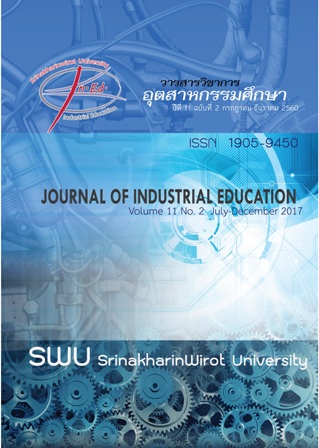รูปแบบการพัฒนาหลักสูตรอาชีวศึกษาไทย
Abstract
บทคัดย่อ การพัฒนาหลักสูตรหมายถึง การจัดทำหลักสูตรขึ้นมาใหม่หรือจัดทำหลักสูตรเดิมให้ดีขึ้น รูปแบบของหลักสูตรเป็นลักษณะเฉพาะ และแสดงความเป็นเอกลักษณ์ของหลักสูตรประเภทนั้น รูปแบบหลักสูตรยังได้เปลี่ยนแปลง ตามวิวัฒนาการของแนวคิดและปรัชญาการศึกษาหลักสูตร การศึกษารูปแบบการพัฒนาหลักสูตรมุ่งส่งเสริมให้สถานศึกษาพัฒนาหลักสูตรได้เองในบริบทของประเทศไทย การสังเคราะห์เป็นรูปแบบสำหรับพัฒนาหลักสูตรอาชีวศึกษาประกอบด้วยรูปแบบการพัฒนาหลักสูตรตามแนวคิดของไทเลอร์ (Ralph W. Tyler) ทาบา (Taba) เซย์เลอร์ อเล็กซานเดอร์ และเลวิส (J. Galen Saylor, William M. Alexander and Arthur J. Lewis) มัลคอล์ม สกิลเบ็ก (Nolker & Schocfeldt) และของไพฑูรย์ นันตะสุคนธ์ โดยนำรูปแบบต่างๆมาวิเคราะห์แจกแจงแบบแมทริกซ์ (Matrix) และสรุปจัดเป็นหมวดหมู่ได้รูปแบบการพัฒนาหลักสูตรอาชีวศึกษาไทย ซึ่งรูปแบบการพัฒนาหลักสูตรอาชีวศึกษาไทยมี 5 ขั้นตอนคือ1.วิเคราะห์สถานการณ์จากสภาพแวดล้อม 2.คัดเลือกเนื้อหา 3.จัดประสบการณ์วิธีการสอน รวมทั้งจัดประสบการณ์การเรียนรู้ 4.การออกแบบประเมินผล 5.นำผลจากการประเมินไปทำการปรับปรุง คำสำคัญ: รูปแบบ, การพัฒนาหลักสูตร Abstract Curriculum Development is defined as the new creation of curriculum or improving in educational course. The structural of curriculum is unique, which shows its own identity, which has been evolutionary changed via the concept and philosophy of education. Accordingly, a study of the development program aims to encourage institutions to improve their own curriculum. In Thailand's context, the synthesis of structural development of vocational education consist of structural development of education by Ralph w. Tyler, Taba, and also from J. Galen Saylor, Willium M. Alexander and Auther J. Lewis combine with the structure of Nolker & Schocfeldt and with Phaitul Nuntasukhon. Thailand's structural development of vocational education uses all of their concept by analyze and clarify then categorize. It can divide into five steps. 1) To analyze the situation of the environment. 2)To select content. 3) To created teaching methods and learning experience. 4) To develop an assessment. 5) To make the improvement from the results of the evaluation. Keywords: Structural, Curriculum DevelopmentDownloads
Download data is not yet available.
Downloads
Issue
Section
บทความวิจัย







